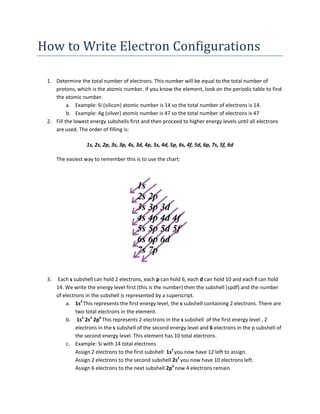
How to Write Electron Configurations
- 1. How to Write Electron Configurations 1. Determine the total number of electrons. This number will be equal to the total number of protons, which is the atomic number. If you know the element, look on the periodic table to find the atomic number. a. Example: Si (silicon) atomic number is 14 so the total number of electrons is 14. b. Example: Ag (silver) atomic number is 47 so the total number of electrons is 47 2. Fill the lowest energy subshells first and then proceed to higher energy levels until all electrons are used. The order of filling is: 1s, 2s, 2p, 3s, 3p, 4s, 3d, 4p, 5s, 4d, 5p, 6s, 4f, 5d, 6p, 7s, 5f, 6d The easiest way to remember this is to use the chart: 3. Each s subshell can hold 2 electrons, each p can hold 6, each d can hold 10 and each f can hold 14. We write the energy level first (this is the number) then the subshell (spdf) and the number of electrons in the subshell is represented by a superscript. a. 1s2 This represents the first energy level, the s subshell containing 2 electrons. There are two total electrons in the element. b. 1s2 2s2 2p6 This represents 2 electrons in the s subshell of the first energy level , 2 electrons in the s subshell of the second energy level and 6 electrons in the p subshell of the second energy level. This element has 10 total electrons. c. Example: Si with 14 total electrons Assign 2 electrons to the first subshell 1s2 you now have 12 left to assign. Assign 2 electrons to the second subshell 2s2 you now have 10 electrons left. Assign 6 electrons to the next subshell 2p6 now 4 electrons remain
- 2. Assign 2 electrons to the next shell 3s2 now 2 electrons remain Assign the last 2 electrons to the next subshell 3p2 . The 3p subshell is not filled since it can hold 6 electrons. 1s2 2s2 2p6 3s2 3p2 This is the correct electron configuration. d. Example: Ag with 47 electrons Assign 2 electrons to the first subshell 1s2 you now have 45 left to assign. Assign 2 electrons to the second subshell 2s2 you now have 43 electrons left. Assign 6 electrons to the next subshell 2p6 now 37 electrons remain Assign 2 electrons to the next shell 3s2 now 35 electrons remain Assign 6 electrons to the next subshell 3p6 now 29 electrons remain Assign 2 electrons to the next subshell 4s2 now 27 electrons remain Assign 10 electrons to the next subshell 3d10 now 17 electrons remain Assign 6 electrons to the next subshell 4p6 and 11 electrons remain Assign 2 electrons to the next subshell 5s2 and 9 electrons remain Assign the last 9 electrons to the next subshell 4d9 this subshell is not filled since it could hold 10 electrons. The complete electron configuration for Ag is: 1s2 2s2 2p6 3s2 3p6 4s2 3d10 4p6 5s2 4d9 4. To determine the valence electrons, first identify the highest number shell. All electrons in this shell (number) are valence no matter what subshell (spdf) they are in. a. For Si 1s2 2s2 2p6 3s2 3p2 All the electrons in shell number 3 are valence, so there are 4 valence electrons. b. For Ag 1s2 2s2 2p6 3s2 3p6 4s2 3d10 4p6 5s2 4d9 all electrons in shell number 5 are valence, so there are 2 valence electrons. 5. If you have the electron configuration, add up all the numerical superscripts to get the total number of electrons. This number will be equal to the atomic number. Look up the atomic number on the periodic table to find the element. 2 2 6 2 6 2 10 6 2 1 a. Example: 1s 2s 2p 3s 3p 4s 3d 4p 5s 4d i. Sum the superscripts ii. 2+2+6+2+6+2+10+6+2+1=39 iii. Atomic number 39 on the periodic table is Y Yttrium.